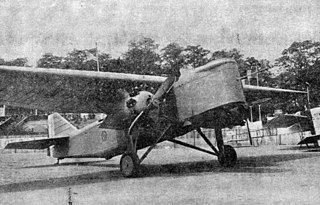Design and development
The factory of S. Poite was well known to French aircraft manufacturers for its expertise in welded light metal structures, particularly their fuel tanks but also fuselage frames [1] such as that of the Bodiansky 20. [2] The Poite 3 is the only known aircraft carrying the factory's name. It was designed by M. Tétart and was an all-metal aircraft. [1]

The fuselage is an aircraft's main body section. It holds crew, passengers, and cargo. In single-engine aircraft it will usually contain an engine, as well, although in some amphibious aircraft the single engine is mounted on a pylon attached to the fuselage, which in turn is used as a floating hull. The fuselage also serves to position control and stabilization surfaces in specific relationships to lifting surfaces, which is required for aircraft stability and maneuverability.
The Bodiansky 20, a French four-seat touring aircraft flown in the early 1930s, was one of the first French aircraft to adopt Handley Page slots to delay the stall and lower landing speed.
The Poite 3 had a three part, low, cantilever wing, built around twin spars and having a high aspect ratio (10.8). There was a rectangular centre-section which filled about one quarter of the span and almost triangular outer panels which carried light dihedral and tapered in thickness. Its ailerons occupied about half the trailing edges of the outer panels and increased in chord inboard. [1]

A cantilever is a rigid structural element, such as a beam or a plate, anchored at one end to a support from which it protrudes; this connection could also be perpendicular to a flat, vertical surface such as a wall. Cantilevers can also be constructed with trusses or slabs. When subjected to a structural load, the cantilever carries the load to the support where it is forced against by a moment and shear stress.

In a fixed-wing aircraft, the spar is often the main structural member of the wing, running spanwise at right angles to the fuselage. The spar carries flight loads and the weight of the wings while on the ground. Other structural and forming members such as ribs may be attached to the spar or spars, with stressed skin construction also sharing the loads where it is used. There may be more than one spar in a wing or none at all. However, where a single spar carries the majority of the forces on it, it is known as the main spar.

In aeronautics, the aspect ratio of a wing is the ratio of its span to its mean chord. It is equal to the square of the wingspan divided by the wing area. Thus, a long, narrow wing has a high aspect ratio, whereas a short, wide wing has a low aspect ratio.
Its fuselage was also in three parts, with the engine mountings forward, a central part including the cabin and a rear section supporting the tail; these sections could be easily separated. It was powered by a 71 kW (95 hp) Renault 4 four-cylinder. upright, air-cooled in-line engine. This was closely and unusually cowled with the cylinders completely enclosed in an upper fairing, tapering in plan, which continued aft to the front of the cabin windscreen framing which it matched in height. There were air intakes in the lower sides of the engine cowling; the fuel tank, disposable in an emergency, was behind the engine. Behind that the well-furnished cabin seated pilot and passenger in tandem, with the pilot over the wing and the passenger just aft of the trailing edge. [1] Its multi-glazed enclosure included long transparencies behind the rear seat, ending close to the tail. Access to each seat was via a side door, to starboard for the forward seat and port for the aft, which when opened also raised the corresponding roof panel; the two roof panels could be opened independently of the doors in flight to allow escapes by parachute. As an alternative arrangement, users could specify open cockpits. [3]

The Renault 4, also known as the 4L, is a hatchback economy car produced by the French automaker Renault between 1961 and 1994. It was the first front-wheel drive family car produced by Renault.

The straight or inline engine is an internal-combustion engine with all cylinders aligned in one row and having no offset. Usually found in four, six and eight cylinder configurations, they have been used in automobiles, locomotives and aircraft, although the term in-line has a broader meaning when applied to aircraft engines, see Inline engine (aviation).
The rear fuselage tapered strongly in profile and ended wider than deep; the leading edge of the high aspect ratio horizontal tail, overall trapezoidal in plan and with rounded tips, was joined to it. The fin of the Poite 3 was tall and narrow, though its unbalanced rudder was more generous; the vertical tail had a blunted triangular profile. The rudder ended clear of the elevators, which were also unbalanced. [1]

The leading edge is the part of the wing that first contacts the air; alternatively it is the foremost edge of an airfoil section. The first is an aerodynamic definition, the second a structural one. As an example of the distinction, during a tailslide, from an aerodynamic point of view, the trailing edge becomes the leading edge and vice versa but from a structural point of view the leading edge remains unchanged.

Balanced rudders are used by both ships and aircraft. Both may indicate a portion of the rudder surface ahead of the hinge, placed to lower the control loads needed to turn the rudder. For aircraft the method can also be applied to elevators and ailerons; all three aircraft control surfaces may also be mass balanced, chiefly to avoid aerodynamic flutter.

Elevators are flight control surfaces, usually at the rear of an aircraft, which control the aircraft's pitch, and therefore the angle of attack and the lift of the wing. The elevators are usually hinged to the tailplane or horizontal stabilizer. They may be the only pitch control surface present, and are sometimes located at the front of the aircraft or integrated into a rear "all-moving tailplane", also called a slab elevator or stabilator.
The Poite 3 had fixed, tail wheel landing gear, mounted from the outer wing centre-section with a track of 2.40 m (7 ft 10 in). Each main wheel leg was based on a pylon formed by an almost vertical, quadrilateral, braced plate from the forward spar with its lower edge joined to the base of a triangular plate, its vertex fixed to the rear spar. Each main wheel axle was mounted on a horizontal U-shaped frame hinged to the bottom of the pylon, with a forked vertical leg containing a rubber-ring Weydert shock absorber attached to a short forward spar extension. The whole structure was enclosed in a trouser-type fairing, with a forward, semi-circular extension for the wheel. The castoring tail wheel had a similar shock absorber and fairing. The main wheels were fitted with independent brakes. [1] [3]

Landing gear is the undercarriage of an aircraft or spacecraft and may be used for either takeoff or landing. For aircraft it is generally both. It was also formerly called alighting gear by some manufacturers, such as the Glenn L. Martin Company.

A shock absorber or damper is a mechanical or hydraulic device designed to absorb and damp shock impulses. It does this by converting the kinetic energy of the shock into another form of energy which is then dissipated. Most shock absorbers are a form of dashpot.
Overall, the Poite 3 was an aerodynamically clean aircraft, with a high aspect ratio wing to minimise induced drag. A maximum lift to drag ratio of 15.4 was calculated, high for a powered aircraft at that time. [1]
The Poite 3 first flew in early August 1930, piloted by Massot. [1] Only the prototype, registered F-ALCZ, was completed. [4] By September 1931 it had been registered to take part in the Official Competition for Touring Aircraft held the following month. [5] No record of its participation or subsequent development has survived.
This page is based on this
Wikipedia article Text is available under the
CC BY-SA 4.0 license; additional terms may apply.
Images, videos and audio are available under their respective licenses.




















